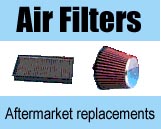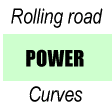 |
Background |
| Filters- what are they? |
The engine in your car has a big appetite for air- the oxygen air contains is vital for the combustion of fuel to generate power. Unfortunately, air also contains dust and debris that causes wear and untold damage to the engine. To help prevent this, you need something to remove these particulates from the air being drawn into the engine- an air filter.
The standard fit filter is a panel made of compressed card- and is very effective at removing particulates from the airstream. Over time it gets dirty and chokes up- that is when it needs to be replaced.
| What are 'performance' filters? |
Unfortunately, standard paper air filters, although cheap and effective at reducing contamination, also impede the entry of air into the engine. They simply don't flow too well. The more air entering the engine will result in more efficient use of the fuel being burnt- and more power. Hence there are a number of manufacturers who supply aftermarket filters whose filters have equivalent filtering ability, but have far superior flow characteristics.
There are two major forms of construction: impregnated cotton gauze and impregnated foam. Foam filters had a poor reputation for filtering ability in the early days- but modern construction techniques are said to overcome this deficiency. However, cotton guaze filters are generally thought to be the superior filter medium.
There are two types of replacement filter you can buy for your car: Panel filters and Cone filters
Panel filters are the easiest to fit, and are straightforward replacements of your existing paper element filter.
Cone filters usually come as part of an induction kit, and involve the removal of some of the standard engine intake manifolding.
Cone filters usually result in the best power gains.
| Which is the best air filter I can fit to my car? |
This is a very good question, as there are alot of filters to choose from. Many would argue that the cone filters with their induction kits work best. The K&N 57i (part number 57-0238) has gained wide acceptance in the MGF community as one of the best options for an aftermarket filter. Independent rolling road tests have demonstrated an 8 BHP gain on standard 1.8i models, and an impressive 15 BHP on the VVC (click here for the power graphs we collected on a variety of filters). At a unit cost of approximately £100 including VAT and delivery within the UK, this represents excellent value for money, at up to 0.15 BHP per pound sterling. This compares favourably with 0.02 BHP per pound sterling or less for a typical new performance exhaust system.
The unique aspect of the K&N kit is the adoption of additional cooling ducts that run from under the car into the engine compartment, reducing the temperature of the air being drawn into the engine by up to six degrees Celsius (figures from Graeme Bishko). The advantage of cold air is that it is denser, and therefore contains more oxygen. More oxygen means a more efficient burn of fuel, and more power.
A common feature of all the cone filters available are that they are attached almost directly to the inlet manifold (via the throttle body/ plenium chamber). This eliminates the somewhat tortuous route that air drawn into the engine has to take as standard (turning over 300 degrees in its 2 metre passage into the engine). This has advantages in terms of the 'ram air' characteristics of a normaly aspirated engine (further explaination, click here). Furthermore, these filters enable high airflow through their elements, have good filtering characteristics, and be washed and re-used almost indefinitely!
Is there any bad news? The majority of insurance companies do not raise premiums for fitment of these airfilters, although I’d advise you check first (for instance, General Accident do not allow for ANY modifications to your car). The issue of the Rover warranty is a little unclear, yet many MG dealerships are enthusiastic about these products and have a liberal policy towards them. Again, it is advisable to check with your dealer before undertaking the modification. Of course, you could always uninstall the filter before you returned your car to the dealership for servicing... In fact, removal is so straight forward, it should enable you to fit a filter to a hire car too, although I wouldn’t necessarily recommend it!